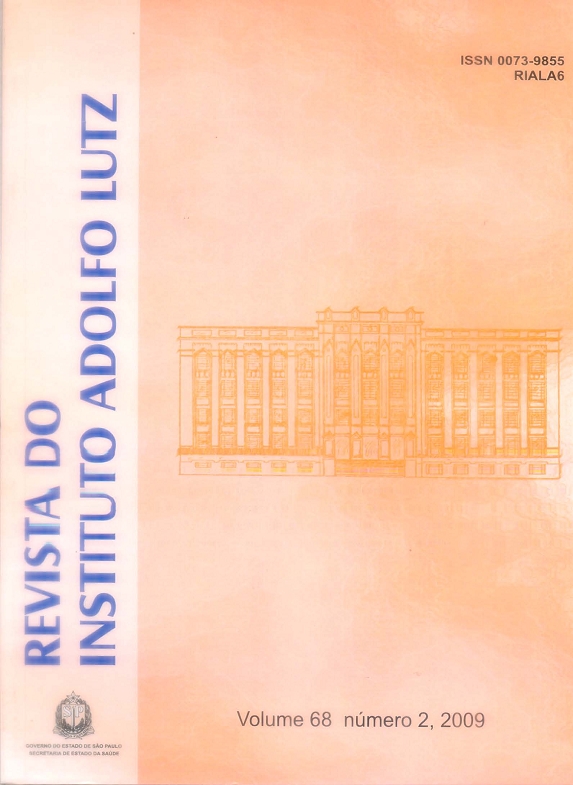Resumo
Com o reconhecimento da má qualidade da água em causar potencial risco aos pacientes em tratamentos dialíticos, foram definidos os parâmetros de avaliação, entre os quais a contagem de bactérias heterotróficas. Considerando que a escolha dos meios de cultura e as condições de incubação utilizadas podem influenciar nos resultados da avaliação microbiológica da água tratada para diálise, este estudo realizou a análise da eficiência do ágar R2A para efetuar a contagem de bactérias heterotróficas. Foram analisadas 193amostras de água tratada provenientes de clínicas de diálise do município de São Paulo e de Grande São Paulo, em que foram avaliadas diferentes temperaturas de incubação, bem como o desempenho analítico de ágar R2A em comparação ao teste realizado com ágar PCA. Não houve diferença significativa entre as contagens obtidas após a incubação por 96 horas a temperaturas de 23oC e 34oC. Entretanto, contagens signifi cativamente maiores foram observadas em ágar R2A (p < 0,02), sendo este, portanto, mais adequado para a avaliação da qualidade de água tratada para diálise. Com a finalidade de minimizar os riscos ao paciente sob tratamento dialítico, recomenda-se o uso do teste em ágar R2A combinado com maior tempo de incubação, em função de sua maior sensibilidade, para a efetuar a contagem de bactérias heterotróficas em água tratada para diálise.
Referências
1. Arvanitidou M, Spaia S, Katsinas C, Pangidis P, Constantinidis T, Katsouyannopoulos V et al. Microbiological quality of water and dialysate in all haemodialysis centres of Greece. Nephrol Dial Transplant. 1988; 13: 949-54.
2. P ontoriero G, Pozzoni P, Andrulli S, Locatelli F. The quality of dialysis water. Nephrol Dial Transplant. 2003; 18 (suppl 7): vii21-5.
3. Silva AMM, Martins CTB, Ferraboli R, Jorgetti V, Romão-Junior JE. Revisão/Atualização em Diálise: Água para hemodiálise. J Bras Nefrol. 1996; 18 (2): 180-8.
4. Varo SD, Martins CHG, Cardoso MJO, Sartori FG, Montanari LB, Pires-Gonçalves RH. Isolamentos e fungos fi lamentosos em água utilizada em uma unidade de hemodiálise. Rev Soc Bras Med Tropical. 2007; 40: 326-31.
5. Vorbeck-Meister I, Sommer R, Vorbeck F, Hörl WH. Quality of water used for haemodialysis: bacteriological and chemical parameters. Nephrol Dial Transplant. 1999; 14: 666-75.
6. Brunet P, Berland Y. Water quality and complications of haemodialysis. Nephrol Dial Transplant. 2000; 15: 578-80.
7. Gomila M, Gascó J, Busquets A, Gil J, Bernabeu R, Buades JM, et al. Identifi cation of culturable bacteria present in haemodialysis water anf fl uid. FEMS Microbiol Ecology. 2005; 52: 101-14.
8. Hoenick NA, Levin R. The implications of water quality in hemodialysis. Semin Dial. 2003; 16 (6): 492-7.
9. Hoenick NA, Ronco C, Levin R. The importance of water quality and haemodialysis fluid composition. Blood Purif. 2006; 24: 11-8.
10. Oie S, Kamiya A, Yoneda I, Uchiyama K, Tsuchida M, Takai K, et al. Microbial contamination of dialysate and its prevention in haemodialysis units. J Hosp Infect. 2003; 54: 115-9.
11. Pérez-Garcia R, Rodríguez-Benitez POC. Why and how to monitor bacterial contamination of dialysate? Nephrol Dial Transplant. 2000; 15: 760-4.
12. Bugno A, Almodóvar, AAB, Pereira TC, Auricchio MT. Detecção de bactérias Gram-negativas não fermentadoras em água tratada para diálise. Rev Inst Adolfo Lutz. 2007; 66 (2): 172-5.
13. Lonnemann G. Assessment of the quality of dialysate. Nephrol Dial Transplant. 1998; 13 (suppl 5): 17-20.
14. van der Linde K, Lim BT, Rondeel JMM, Antonissen LPMT, de Jong GMT. Improved bacteriological surveillance of haemodilysis fl uids: a comparison between Tryptic soy agar and Reasoner’s 2A media. Nephrol Dial Transplant. 1999; 14, 2433-7.
15. Brasil. Ministério da Saúde. Resolução RDC nº154, de 15 de jun. 2004 (versão republicada em 31 de mai. 2006). Estabelece o Regulamento Técnico para funcionamento dos Serviços de Diálise. Diário Oficial [da] República Federativa do Brasil, Poder Executivo, Brasília, 31 mai. 2006. Disponível em: http://e-legis.anvisa.gov.br/leisref/public/showAct.php?id=22875&word.
16. Archibald LK, Khoi NN, Jarvis WR, Reller LB, Cam PD, Thu TA, et al. Pyrogenic reactions in hemodialysis patients, Hanoi, Vietnam. Infect Control Hosp Epidemiol. 2006; 27 (4): 424-6.
17. Reasoner DJ. Heterotrophic plate count methodology in the United States. Int J Food Microbiol. 2004; 92: 307-15.
18. Allen MJ, Edberg SC, Reasoner DJ. Heterotrophic plate count bacteria – what is their signifi cance in drinking water? Int J Food Microbiol. 2004; 92: 265-74.
19. United States Pharmacopeia (US). The United States Pharmacopeia. 31 ed. Rockville: United States Pharmacopeial Convention; 2008.
20. American Public Health Association (US). Standard Methods for the examination of Water and Wasterwater. Baltimore: United Book Press, Inc; 1998.
21. Carter JT, Rice EW, Buchberger SG, Lee Y. Relationships between levels of heterotrophic bacteria and water quality parameters in a drinking water distribution system. Water Research. 2000; 34 (5): 1495-502.
22. Uhl W, Schaule G. Establishment of HPC(R2A) for regrowth control in non-chlorinated distribution systems. Int J Food Microbiol. 2004; 92: 317-25.

Este trabalho está licenciado sob uma licença Creative Commons Attribution 4.0 International License.
Copyright (c) 2009 Adriana Aparecida Buzzo Almódovar, Tatiana Caldas Pereira, Adriana Bugno
